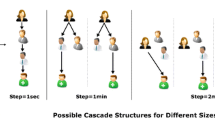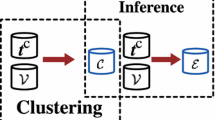Abstract
Diffusion network inference aims to reveal the message propagation process among users and has attracted many research interests due to the fundamental role it plays in some real applications, such as rumor-spread forecasting and epidemic controlling. Most existing methods tackle the task with exact node infection time. However, collecting infection time information is time-consuming and labor-intensive, especially when information flows are huge and complex. To combat the problem, we propose a new diffusion network inference algorithm that only relies on infection states. The proposed method first encodes several observation states into a node infection matrix and then obtains the node embedding via the variational autoencoder (VAE). Nodes with the least Wasserstein distance of embeddings are predicted for existing propagation edges. Meanwhile, to reduce the complexity, a novel clustering-based filtering strategy is designed for selecting latent propagation edges. Extensive experiments show that the proposed model outperforms the state-of-the-art infection time independent models while demonstrating comparable performance over infection time based models.
Access this chapter
Tax calculation will be finalised at checkout
Purchases are for personal use only
Similar content being viewed by others
References
Adamic, L.A., Glance, N.: The political blogosphere and the 2004 us election: divided they blog. In: Proceedings of the 3rd International Workshop on Link Discovery, pp. 36–43 (2005)
Amin, K., Heidari, H., Kearns, M.: Learning from contagion (without timestamps). In: International Conference on Machine Learning. PMLR (2014)
Clauset, A., Moore, C., Newman, M.E.: Hierarchical structure and the prediction of missing links in networks. Nature 453(7191), 98–101 (2008)
Doersch, C.: Tutorial on variational autoencoders. arXiv preprint arXiv:1606.05908 (2016)
Erdos, P., Rényi, A., et al.: On the evolution of random graphs. Publ. Math. Inst. Hung. Acad. Sci 5(1), 17–60 (1960)
Givens, C.R., Shortt, R.M.: A class of Wasserstein metrics for probability distributions. Mich. Math. J. 31(2), 231–240 (1984)
Gomez-Rodriguez, M., Leskovec, J., Krause, A.: Inferring networks of diffusion and influence. ACM Trans. Knowl. Discov. Data (TKDD) 5(4), 1–37 (2012)
Gripon, V., Rabbat, M.: Reconstructing a graph from path traces. In: 2013 IEEE International Symposium on Information Theory. IEEE (2013)
Han, K., Tian, Y., Zhang, Y., Han, L., Huang, H., Gao, Y.: Statistical estimation of diffusion network topologies. In: 2020 IEEE 36th International Conference on Data Engineering (ICDE), pp. 625–636. IEEE (2020)
Hartigan, J.A., Wong, M.A.: Algorithm as 136: a k-means clustering algorithm. J. Roy. Stat. Soc. Ser. C (Appl. Stat.) 28, 100–108 (1979)
Huang, H., Yan, Q., Gan, T., Niu, D., Lu, W., Gao, Y.: Learning diffusions without timestamps. In: Proceedings of the AAAI Conference on Artificial Intelligence, vol. 33, pp. 582–589 (2019)
Kefato, N.Z., Montresor, A.: DeepInfer: diffusion network inference through representation learning. In: Proceedings of the 13th International Workshop Mining Learning Graphs (2017)
Kefato, Z.T., Sheikh, N., Montresor, A.: REFINE: representation learning from diffusion events. In: Nicosia, G., Pardalos, P., Giuffrida, G., Umeton, R., Sciacca, V. (eds.) LOD 2018. LNCS, vol. 11331, pp. 141–153. Springer, Cham (2018). https://doi.org/10.1007/978-3-030-13709-0_12
Kipf, T.N., Welling, M.: Variational graph auto-encoders. arXiv preprint arXiv:1611.07308 (2016)
Kurashima, T., Iwata, T., Takaya, N., Sawada, H.: Probabilistic latent network visualization: inferring and embedding diffusion networks. In: Proceedings of the 20th ACM SIGKDD International Conference on Knowledge Discovery and Data Mining, pp. 1236–1245 (2014)
Leskovec, J., Chakrabarti, D., Kleinberg, J., Faloutsos, C., Ghahramani, Z.: Kronecker graphs: an approach to modeling networks. J. Mach. Learn. Res. 11(2) (2010)
Leskovec, J., Lang, K.J., Dasgupta, A., Mahoney, M.W.: Statistical properties of community structure in large social and information networks. In: Proceedings of the 17th International Conference on World Wide Web, pp. 695–704 (2008)
Leskovec, J., Mcauley, J.: Learning to discover social circles in ego networks. Adv. Neural Inf. Process. Syst. 25 (2012)
Lusseau, D., Schneider, K., Boisseau, O.J., Haase, P., Slooten, E., Dawson, S.M.: The bottlenose dolphin community of doubtful sound features a large proportion of long-lasting associations. Behav. Ecol. Sociobiol. 54(4), 396–405 (2003)
Mikolov, T., Sutskever, I., Chen, K., Corrado, G.S., Dean, J.: Distributed representations of words and phrases and their compositionality. Adv. Neural Inf. Process. Syst. 26 (2013)
Rodriguez, M.G., Leskovec, J., Balduzzi, D., Schölkopf, B.: Uncovering the structure and temporal dynamics of information propagation. Netw. Sci. 2(1), 26–65 (2014)
Wang, H., Banerjee, A.: Bregman alternating direction method of multipliers. In: Advances in Neural Information Processing Systems, vol. 27. Curran Associates, Inc. (2014)
Xia, Y., Chen, T.H.Y., Kivelä, M.: Applicability of multilayer diffusion network inference to social media data. arXiv preprint arXiv:2111.06235 (2021)
Zhu, D., Cui, P., Wang, D., Zhu, W.: Deep variational network embedding in Wasserstein space. In: Proceedings of the 24th ACM SIGKDD International Conference on Knowledge Discovery & Data Mining (2018)
Acknowledgements
This work was funded by the National Natural Science Foundation of China under grant numbers U1836111 and the National Social Science Fund of China under grant number 19ZDA329.
Author information
Authors and Affiliations
Corresponding author
Editor information
Editors and Affiliations
Rights and permissions
Copyright information
© 2023 Springer Nature Switzerland AG
About this paper
Cite this paper
Chen, G., Wang, Y., Shao, J., Shi, B., Shen, H., Cheng, X. (2023). InDNI: An Infection Time Independent Method for Diffusion Network Inference. In: Chang, Y., Zhu, X. (eds) Information Retrieval. CCIR 2022. Lecture Notes in Computer Science, vol 13819. Springer, Cham. https://doi.org/10.1007/978-3-031-24755-2_6
Download citation
DOI: https://doi.org/10.1007/978-3-031-24755-2_6
Published:
Publisher Name: Springer, Cham
Print ISBN: 978-3-031-24754-5
Online ISBN: 978-3-031-24755-2
eBook Packages: Computer ScienceComputer Science (R0)




